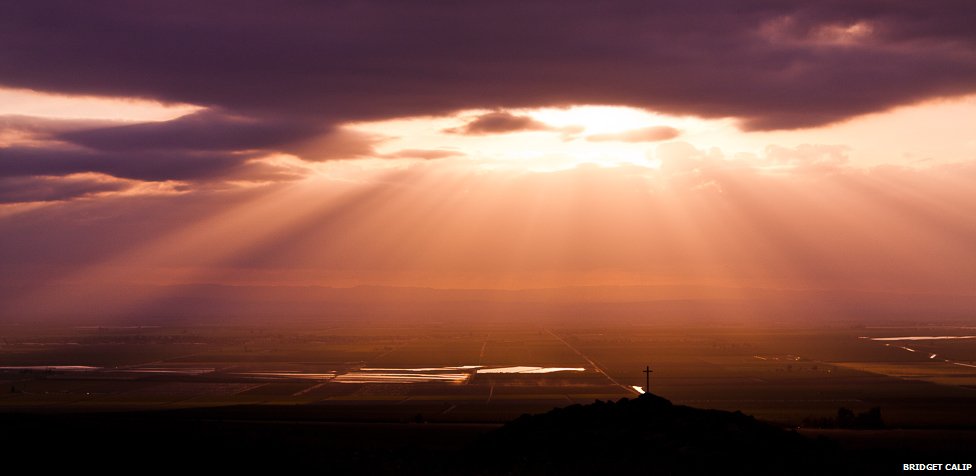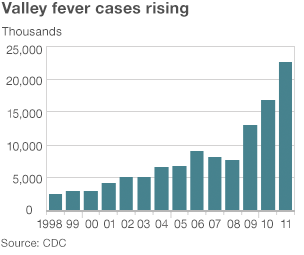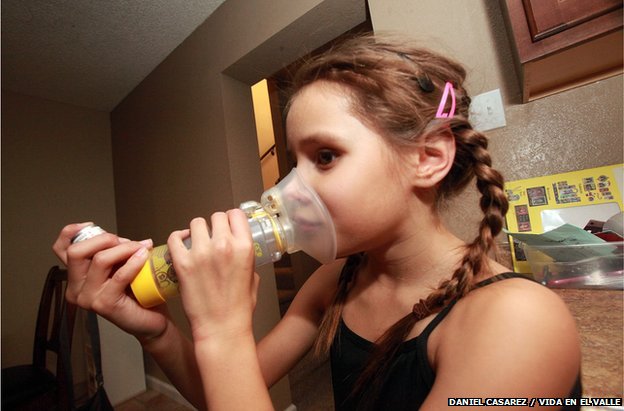Tom Geoghegan
BBC
July 17, 2013
 Cases of an incurable illness called valley fever are multiplying at an alarming and mystifying rate in the American south-west. Six states are affected, and Mexico too, but few places have been hit as hard as one remote city.
Cases of an incurable illness called valley fever are multiplying at an alarming and mystifying rate in the American south-west. Six states are affected, and Mexico too, but few places have been hit as hard as one remote city.
Even in sweltering heat, the wind brings no respite to Avenal.
The gusts are warm, like a hairdryer, and they carry an invisible threat that has claimed and disrupted many lives.
 The tiny city of 14,000 people, nestling in a dip in the floor of the San Joaquin Valley, California, is what experts refer to as a “hot zone” for coccidioidomycosis – an illness caused by the inhalation of tiny fungal spores that usually reside in the soil.
The tiny city of 14,000 people, nestling in a dip in the floor of the San Joaquin Valley, California, is what experts refer to as a “hot zone” for coccidioidomycosis – an illness caused by the inhalation of tiny fungal spores that usually reside in the soil.
Described by the Centers for Disease Control as a silent epidemic, 22,401 new infections were recorded across the US in 2011, mostly in the south-west, up tenfold from 1998. Although two-thirds of those infected suffer no symptoms, and the illness is not contagious, about 160 people die each year when the fungus spreads beyond the lungs to the brain.
Avenal is at the centre of the epidemic. While millions flock to the famous Californian beaches a couple of hours to the west and to Yosemite National Park to the east, they rarely linger in the San Joaquin Valley, the state’s agricultural heartland. Avenal has the air of a forgotten place.
The landscape looks parched and a perpetual haze hangs on the horizon, obscuring the distant mountain ranges.
Pulling up in sleepy Kings Street, there is little sign of life, just some boys on bikes circling in the street while their friend looks on.
In the Gallery Cafe, staff are making sandwiches for three council workers while opposite them, on the wall, a portrait serves as a reminder of the human cost of this terrible illness.

Maria Eugenia Pena died six years ago, aged 39 and pregnant.
Her son Osvaldo Contreras, who runs the cafe with his brother, says he thinks about her every day and wonders every time he gets a headache whether he will be next.
“On windy days you are more conscious of it,” says one of Osvaldo’s customers, Enrique Jimenez. “You breathe in through your nose, and try not to breathe in as much dust. I worked in the fields for a long time, my father managed a few crops out here, and we took precautions, wearing bandanas.”
This was not enough to protect Jimenez’s father, who suffered breathing problems for a year before he was diagnosed with valley fever. Long afterwards, he is still receiving treatment.
You’re never rid of it, says Mary Garcia, who works in Subway, a few doors along from the cafe.
“There are times I wake up and I’m in a lot of pain. It’s like the worst fever you’ve ever had from a flu,” she adds.
She caught valley fever 10 years ago, and sometimes, when the wind blows, it returns.
If any of her children get it, she says she will move away.
Jim McGee is one of those already making plans to get out. Three of his children are still recovering from valley fever, and his baby grandson Victor is now being tested for it.
